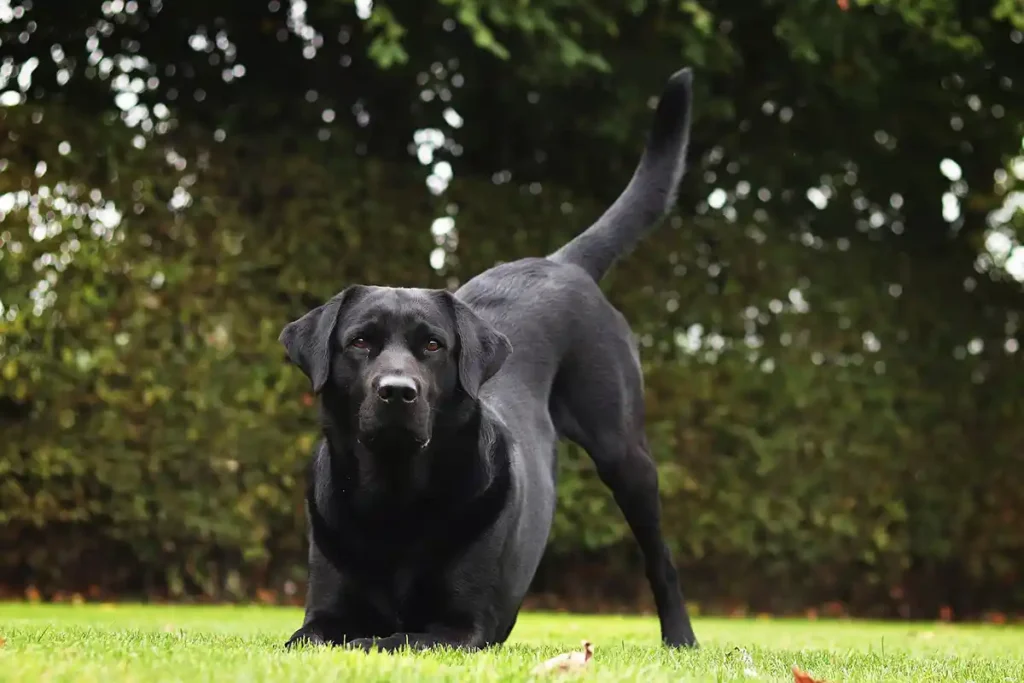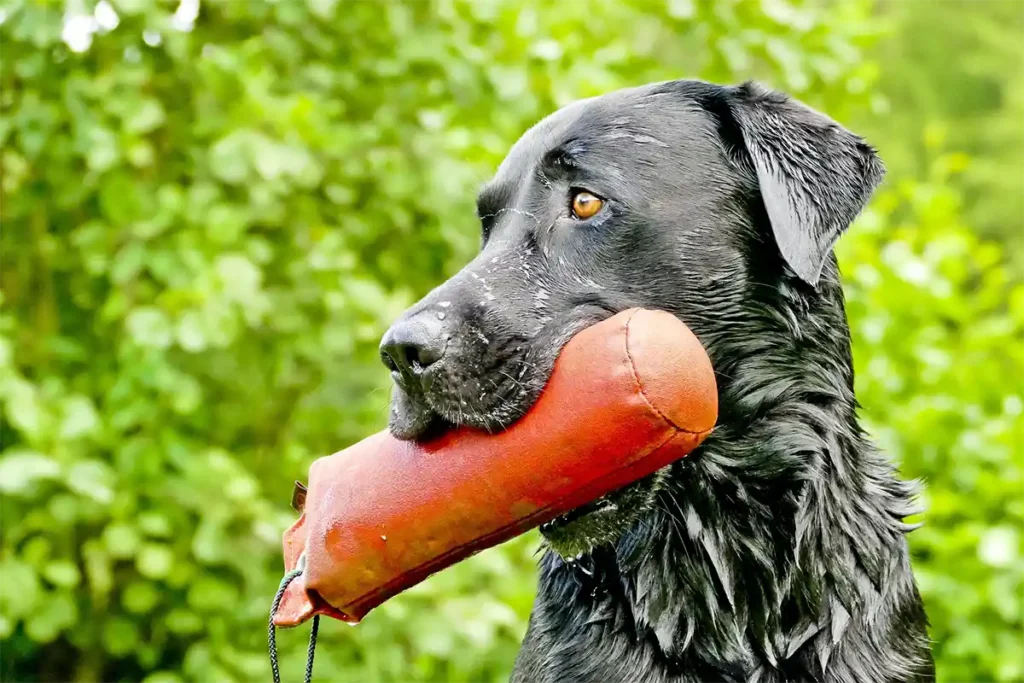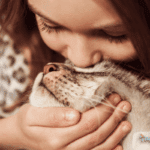The Labrador Retriever, often hailed as America’s sweetheart, is a versatile and loyal companion. Known for their intelligence, affectionate nature, and boundless energy, Labs are beloved by families, outdoor enthusiasts, and dog lovers worldwide. Their adaptability and trainability make them perfect for a variety of roles, from family pet to working dog, and even therapy or assistance companions.
Whether they’re chasing a ball at the park, accompanying you on a hike, or curling up at your feet after a long day, Labrador Retrievers bring joy, enthusiasm, and unwavering loyalty to any home.
Labrador Retrievers are known for their intelligence and obedience. Learning “Essential Dog Training Commands” can further enhance their capabilities.
Quick Facts: Labrador Retriever
Here’s a snapshot of the Labrador Retriever’s traits to give you a better understanding of this extraordinary breed:
| Characteristic | Description | Rating |
|---|---|---|
| Size | Males: 22–24 in (56–61 cm), 65–80 lbs (29–36 kg); Females slightly smaller | ⭐⭐⭐⭐⭐ |
| Average Lifespan | 10–12 years | ⭐⭐⭐ |
| Intelligence Ranking | Highly intelligent and eager to please | ⭐⭐⭐⭐⭐ |
| Exercise Requirements | High; 1–2 hours of activity daily | ⭐⭐⭐⭐⭐ |
| Grooming Needs | Low; occasional brushing to control shedding | ⭐⭐⭐ |
| Training Adaptability | Exceptionally trainable with positive reinforcement | ⭐⭐⭐⭐⭐ |
| Compatibility with Children | Excellent; gentle and patient with kids | ⭐⭐⭐⭐⭐ |
| Energy Level | High; playful and active | ⭐⭐⭐⭐⭐ |
| Shedding Level | Moderate; seasonal shedding | ⭐⭐⭐ |
| Apartment Living | Possible with sufficient exercise | ⭐⭐⭐ |
| Health Issues | Prone to hip dysplasia, obesity, and joint issues | ⭐⭐⭐ |
| Cost of Ownership | Moderate to high; includes food, grooming, and vet care | ⭐⭐⭐ |
| Vocal Tendency | Moderate; barks to alert or communicate | ⭐⭐ |
| Social Needs | Very high; thrives on companionship and attention | ⭐⭐⭐⭐⭐ |
- • Highly Trainable: Labs rank among the smartest breeds, thriving in roles like service, hunting, and therapy.
- • Loyal and Loving: They form deep emotional bonds with their families.
- • Active and Energetic: Labradors require plenty of exercise and mental stimulation to stay happy and healthy.
- • Family-Friendly: Their gentle temperament makes them great with children and other pets.

History and Origins of the Labrador Retriever
The Labrador Retriever, often regarded as America’s favorite breed, traces its roots back to the rugged coasts of Newfoundland, Canada. Initially bred to assist fishermen, this intelligent and hardworking breed became renowned for its versatility, loyalty, and enduring charm. Over the centuries, Labradors have evolved from working dogs to beloved family pets, earning their place as one of the most popular and adaptable dog breeds worldwide.
Quick Facts About Labrador Retriever Origins
| Aspect | Detail |
|---|---|
| Geographic Origin | Newfoundland, Canada |
| Purpose | Assisting fishermen with retrieving nets, fish, and equipment |
| First Recognition | Recognized by the Kennel Club of England in 1903 |
| Introduction to the U.S. | Early 20th century; became popular among hunters and families |
| Notable Contributions | Service dogs, therapy dogs, search-and-rescue, and sporting roles |
| Breed Development | Ancestors include the St. John’s Water Dog and other local breeds |
Labrador Retriever Breed Development in Newfoundland
In the mid-19th century, Lord Dudley Marjoribanks, later known as Lord Tweedmouth, sought to During the 18th and 19th centuries, fishermen in Newfoundland relied on sturdy, intelligent dogs to assist with essential tasks like hauling fishing nets and retrieving gear from icy waters. These early Labradors, known as St. John’s Water Dogs, had dense double coats for protection against cold waters and webbed feet that made them exceptional swimmers.
Their remarkable adaptability and willingness to work caught the attention of British visitors, who began importing these dogs to England. Under the care of nobles like the Earl of Malmesbury, Labradors were selectively bred to enhance traits like their retrieving ability, temperament, and stamina, making them ideal hunting companions.
From Working Dog to Family Companion
Although Labradors were initially valued for their utility in fishing and hunting, their gentle and friendly nature soon made them household favorites. By the early 20th century, Labradors gained recognition in North America and quickly became sought after for their loyalty, intelligence, and ease of training.
A Breed of Many Talents
Labradors’ versatility has allowed them to excel in a variety of roles:
- Beloved Family Pets: Their playful and affectionate temperament ensures they integrate seamlessly into family life.
- Service and Therapy Dogs: Their calm and dependable nature makes them ideal for assisting individuals with disabilities or emotional needs.
- Search-and-Rescue Heroes: Labradors’ keen senses and energy make them reliable partners in rescue missions.
- Sporting Companions: Their natural retrieving instincts and endurance make them excellent hunting and sporting dogs.
Why the Labrador Retriever Stands Out
From Newfoundland’s icy shores to modern homes and workplaces, the Labrador Retriever’s journey is one of purpose and adaptability. Their ability to seamlessly transition between working roles and family life sets them apart as a breed that truly does it all. Whether helping fishermen, assisting hunters, or snuggling with loved ones on the couch, Labradors embody the perfect balance of work and companionship.
Before welcoming a Labrador Retriever into your home, consider these “10 Essential factors for bringing a new pet home”.

Personality Traits of the Labrador Retriever
The Labrador Retriever, cherished for its friendly, loyal, and intelligent nature, is among the most popular dog breeds worldwide. Their adaptable personality makes them perfect for families, active individuals, and those seeking a devoted and trainable companion. Whether at play or rest, Labradors radiate joy, warmth, and affection.
Table: Labrador Retriever Personality Profile
| Trait | Description |
|---|---|
| Intelligence | Highly intelligent and quick learners; excel in obedience, problem-solving, and advanced training. |
| Energy Level | High energy; require 1–2 hours of exercise daily to maintain happiness and health. |
| Social Interaction | Extremely affectionate; bonds deeply with family and is welcoming to strangers. |
| Protectiveness | Friendly by nature; will alert owners but not overly protective or aggressive. |
| Trainability | Exceptionally trainable; eager to please with positive reinforcement techniques. |
| Compatibility with Kids | Excellent; gentle and patient, making them great for families with children. |
| Compatibility with Pets | Very sociable; thrives in multi-pet households with proper introductions and socialization. |
Loyal and Affectionate Companions
Labradors are renowned for their loyalty and affection. They form deep emotional bonds with their families, thriving in homes where they are active members of the household. Their natural warmth and “people dog” personality make them ideal for owners seeking a devoted and interactive pet.
Real-Life Example: Labrador owners frequently share touching anecdotes, such as their dog instinctively comforting a sick child or eagerly waiting by the door for a family member to return.
Energetic and Playful
Labradors maintain a playful spirit throughout their lives. Their high energy levels mean they thrive in active households and need regular physical and mental stimulation to prevent boredom. Without sufficient activity, they may resort to behaviors like chewing or digging.
Exceptionally Intelligent and Trainable
Among the smartest dog breeds, Labradors excel in obedience, problem-solving, and advanced training. Their eagerness to please makes them a favorite for roles in therapy, service, and even competitive sports.
Pro Tip: Use short, engaging training sessions with positive reinforcement such as treats, verbal praise, or play. This approach helps Labs stay focused and motivated to learn commands and tricks.
Real-Life Example: Labradors often shine in roles requiring advanced skills, from therapy programs to search-and-rescue missions. Their intelligence and trainability are demonstrated in tasks like retrieving objects, opening doors, or even assisting individuals with disabilities.
Friendly and Social
Labradors are naturally outgoing and thrive in social environments. Their gentle, welcoming demeanor extends to family members, visitors, and even strangers. This sociable nature ensures they bring warmth and joy wherever they go.
Key Insight: Early socialization ensures your Labrador grows up confident and well-mannered, particularly around unfamiliar situations, visitors, and other pets.
Real-Life Example: Many families with multiple pets describe their Labrador as the “peacekeeper,” effortlessly bonding with cats, other dogs, and children.
Calm Yet Emotionally Attuned
While energetic and playful, Labradors are also remarkably sensitive to human emotions. Their ability to read and respond to their owners’ moods makes them exceptional therapy and emotional support animals.
Fun Fact: Labradors’ expressive eyes and wagging tails have been described as “emotional mirrors,” communicating affection, empathy, and excitement.
Real-Life Example: Labrador owners often recount stories of their dog instinctively providing comfort during tough times, such as resting their head on a loved one’s lap or staying close during illness.
Why Choose a Labrador Retriever?
If you’re seeking a loving, intelligent, and endlessly loyal companion, the Labrador Retriever is an unbeatable choice. Their adaptable nature ensures they integrate seamlessly into any household, whether as a family pet, a working dog, or a supportive therapy companion. With proper care, exercise, and attention, Labradors will reward you with years of joy, companionship, and unconditional love.
Labrador Retrievers are celebrated for their intelligence and eagerness to please. Mastering “Essential Dog Training Commands” can help bring out their full potential.
Labrador Retrievers thrive on companionship but can develop separation anxiety. Learn more about “Understanding and Managing separation anxiety in dogs”.

Physical Characteristics of the Labrador Retriever
The Labrador Retriever, known for its strong, athletic build and friendly demeanor, is a breed that perfectly balances functionality and charm. Originally bred to assist fishermen and hunters, every aspect of their physical traits reflects their adaptability, stamina, and approachable nature. These characteristics make Labradors one of the most beloved and versatile dog breeds globally.
Size and Build
| Trait | Description |
|---|---|
| Average Height | Males: 22–24 in (56–61 cm); females: 21.5–23.5 in (54–59.5 cm) |
| Average Weight | Males: 65–80 lbs (29–36 kg); females: 55–70 lbs (25–32 kg) |
| Body Type | Muscular, well-proportioned, and athletic |
Labradors are built for strength and endurance. Their deep chest, powerful legs, and straight back enable them to excel in demanding activities like swimming, hiking, and retrieving. Despite their robust build, they maintain a graceful and approachable appearance, embodying both strength and friendliness.
Notable Features
Labradors are instantly recognizable by their expressive eyes, pendant-shaped ears, and iconic otter-like tail. These features not only add to their charm but also serve practical purposes.
- Eyes: Medium-sized, hazel or brown, radiating warmth and intelligence.
- Ears: Soft, pendant-shaped, and medium-sized, framing their kind expression.
- Muzzle: Broad and strong, perfect for their “soft mouth” ability to carry items gently.
- Tail: Thick and otter-like, carried level with the back, showcasing their energy and enthusiasm.
Their smooth gait and balanced posture reflect their athletic roots, making them capable of excelling in both work and play.
Coat and Colors
| Trait | Description |
|---|---|
| Coat Type | Double coat: dense, water-resistant outer layer with a soft insulating undercoat |
| Coat Texture | Straight or slightly wavy, providing durability and protection |
| Coloring | Solid black, yellow (ranging from cream to fox-red), or chocolate |
The Labrador Retriever’s double coat is a hallmark of the breed, offering protection against harsh weather while maintaining a sleek, polished appearance. The outer coat repels water and dirt, while the insulating undercoat keeps them warm during outdoor activities. Seasonal shedding, particularly in spring and fall, makes regular grooming essential.
Facial Features and Posture
| Feature | Description |
|---|---|
| Eyes | Medium-sized, hazel or brown, conveying intelligence and curiosity |
| Ears | Pendant-shaped and medium-sized, enhancing their approachable demeanor |
| Tail | Otter-like, thick, and carried level with the back, showcasing their energy |
Labradors’ physical presence exudes balance and confidence. Whether standing tall or bounding playfully, their poise and fluid movement reflect their working-dog heritage.
Key Physical Traits of the Labrador Retriever
- Athletic Build: Labradors’ strength and agility make them ideal for outdoor activities like swimming, running, and hiking.
- Distinctive Double Coat: Their water-resistant coat is functional and visually striking but requires regular maintenance.
- Iconic Colors: Black, yellow, and chocolate shades make Labradors instantly recognizable and universally loved.
- Expressive Features: Their kind eyes, wagging tails, and soft ears are hallmarks of their friendly and affectionate personality.
Why Understanding These Characteristics Matters
Appreciating the physical traits of Labradors helps owners better meet their grooming, exercise, and overall care needs. Their double coat and athletic build are not just aesthetic—they serve a practical purpose, supporting their active and versatile lifestyle.
Why the Alaskan Malamute Stands Out
The Labrador Retriever’s physical traits are a remarkable blend of strength, versatility, and approachability. With their sleek, water-resistant coat, athletic build, and iconic otter-like tail, Labradors are among the most recognizable and beloved dog breeds worldwide. Their stamina, intelligence, and adaptability make them ideal for various roles, including hiking companions, service dogs, therapy animals, and loyal family pets. For those seeking a breed that excels in functionality, loyalty, and charm, the Labrador Retriever remains a top choice.
Did you know that some Labrador Retrievers love sticking out their tongues? Find out other reasons why in this vet-reviewed guide.

Health and Lifespan of the Labrador Retriever
Labrador Retrievers are cherished for their playful energy and affectionate nature, but like all breeds, they are prone to certain health conditions. With an average lifespan of 10 to 12 years, Labradors can thrive with proper care, regular veterinary checkups, and an active lifestyle. Proactive health management is key to ensuring they remain the loyal and vibrant companions they are known to be.
Average Lifespan of the Labrador Retriever
The average lifespan of a Labrador Retriever is 10 to 12 years, influenced by factors like genetics, diet, exercise, and preventive care. While Labradors are resilient, their predisposition to specific health concerns highlights the importance of early detection and regular wellness routines.
Common Health Issues in the Labrador Retriever
Labradors are predisposed to several hereditary and lifestyle-related health conditions. Awareness and early intervention can significantly improve their quality of life.
| Condition | Description |
|---|---|
| Hip Dysplasia | Improper development of the hip joint, leading to pain and arthritis. |
| Elbow Dysplasia | Abnormal development of the elbow joint, causing discomfort and reduced mobility. |
| Obesity | Excess weight can strain joints, increase the risk of diabetes, and shorten lifespan. |
| Ear Infections | Moisture in floppy ears creates an environment for bacterial or yeast growth. |
| Progressive Retinal Atrophy | A genetic condition causing gradual vision loss and eventual blindness. |
| Cruciate Ligament Injury | Common in active breeds, this orthopedic injury can require surgical intervention. |
Preventive Care and Regular Vet Checkups
Preventive care is the cornerstone of keeping Labrador Retrievers healthy and active. Regular veterinary visits, proper grooming, and maintaining an active lifestyle can help address potential health concerns before they become serious.
| Health Aspect | Recommended Action | Frequency |
|---|---|---|
| Hip and Joint Health | Watch for stiffness; provide joint supplements if needed. | Annually or as needed |
| Weight Management | Offer portion-controlled meals and encourage daily activity. | Monthly monitoring |
| Dental Care | Brush teeth and use dental chews to prevent plaque buildup. | Weekly; annual cleaning |
| Ear Hygiene | Clean ears weekly to prevent infections. | Weekly |
| Cancer Screenings | Schedule regular exams to detect lumps or abnormalities early. | As recommended by your vet |
| Vision Health | Monitor for signs of PRA; consult your vet for screenings. | Annually |
Signs of Illness to Watch For in
Recognizing early symptoms can prevent small issues from becoming serious health concerns. Monitor your Labrador Retriever for:
- Mobility Issues: Stiffness, limping, or difficulty standing, which may indicate joint problems.
- Unexplained Weight Changes: Sudden weight gain or loss could signal metabolic disorders or chronic illnesses.
- Excessive Scratching or Ear Odor: Common signs of ear infections in Labradors.
- Lethargy or Fatigue: Reduced energy levels may point to obesity, heart issues, or other health concerns.
- Digestive Problems: Vomiting, bloating, or gas could indicate gastrointestinal issues.
- Vision Changes: Difficulty navigating in low light may be a sign of PRA.
Some owners explore options like “CBD oil for dogs” to manage joint discomfort.
Labrador Retrievers may face certain health challenges. Stay informed about the “11 Warning signs your dog needs a vet visit”.
Ensuring a Healthy Life for Your Labrador Retriever
Proactive care is essential for ensuring your Labrador thrives. Their energetic nature and affectionate personality require a combination of physical activity, mental enrichment, and attentive healthcare.
Key Areas of Care:
- Balanced Nutrition: Feed a high-quality diet tailored to your Labrador’s age, size, and activity level. Avoid overfeeding to prevent obesity.
- Regular Exercise: Aim for 1–2 hours of activity daily, such as swimming, fetch, or agility games.
- Grooming and Hygiene: Clean ears weekly and brush their coat regularly to prevent infections and keep their fur shiny.
- Routine Veterinary Screenings: Schedule annual checkups, joint assessments, and cancer screenings for early detection.
Why Health Awareness Matters
Understanding the unique health needs of Labrador Retrievers allows you to provide the care they need to lead long, happy lives. By prioritizing preventive care and staying vigilant for signs of illness, you can ensure your Labrador remains a playful and loving companion for many years to come.

Caring for an Labrador Retriever: Grooming, Diet and Enrichment Tips
Labrador Retrievers thrive when their physical, mental, and emotional needs are met. Their playful energy, affectionate nature, and intelligence make them exceptional companions, but they require attentive care to remain healthy and happy. By focusing on grooming, nutrition, and consistent enrichment, owners can help their Labradors lead vibrant and fulfilling lives.
Table: Care Requirements for Labrador Retriever
| Care Aspect | Requirement Level | Frequency | Details | Importance Rating |
|---|---|---|---|---|
| Grooming | High | Weekly | Brushing, bathing, and ear cleaning to manage shedding and maintain coat health. | ⭐⭐⭐⭐⭐ |
| Feeding | High | Daily | High-quality protein diet with portion control to prevent obesity. | ⭐⭐⭐⭐⭐ |
| Exercise | Very High | Daily | 1–2 hours of physical activity such as walks, swimming, and play. | ⭐⭐⭐⭐⭐ |
| Mental Stimulation | Very High | Continuous | Training, puzzle toys, and interactive games to engage their intelligence. | ⭐⭐⭐⭐⭐ |
| Environment | High | Continuous | Comfortable resting spaces and safe outdoor areas for play. | ⭐⭐⭐⭐ |
Grooming: Keeping That Sleek Labrador Shine
Labradors have a water-resistant double coat that sheds year-round and requires regular care to stay healthy. Without proper grooming, their coat may become dull, matted, or prone to skin irritations.
Key Grooming Practices:
- Brushing: Use a slicker or de-shedding brush weekly to remove loose fur, reduce shedding, and distribute natural oils. During heavy shedding seasons, increase brushing frequency.
- Bathing: Bathe every 4–6 weeks with a gentle, dog-safe shampoo to maintain a clean, shiny coat. Read more on “How to bathe your dog stress-free“
- Ear Care: Clean ears weekly with a vet-approved solution to prevent infections caused by trapped moisture.
- Nail Trimming: Trim nails every 2–3 weeks to prevent overgrowth and discomfort.
- Dental Hygiene: Brush teeth 2–3 times a week and provide dental chews to maintain oral health.
Diet and Nutrition: Fueling Their Energy and Vitality
Labradors are high-energy dogs that require nutritionally balanced meals to support their health and activity levels.
Key Nutritional Needs:
- High-Quality Protein: Select dog food with real meat or fish as the primary ingredient to support lean muscle mass.
- Healthy Fats: Include Omega-3 and Omega-6 fatty acids to promote a shiny coat and healthy skin.
- Controlled Portions: Prevent obesity by feeding appropriate portions based on age, weight, and activity level.
Feeding Schedule:
- Adults: Provide two balanced meals daily.
- Puppies: Offer 3–4 smaller meals to support growth and development.
Hydration
Always provide fresh water, especially after exercise or during warm weather. Active dogs like Labradors require consistent hydration to stay healthy.
Exercise: Meeting Their Energy Needs
Labradors are naturally active and require daily exercise to prevent boredom and maintain optimal health. Regular physical activity also helps manage weight, supports joint health, and improves their mental well-being.
Physical Activity Recommendations:
- Daily Exercise: Provide 1–2 hours of activity, including walks, swimming, and games of fetch.
- Low-Impact Activities: Swimming is particularly beneficial for joint health and provides a full-body workout.
- Agility and Sports: Engage in agility training or scent-tracking games to challenge their minds and bodies.
Mental Stimulation:
Labradors are highly intelligent and thrive on mental challenges. Keep their minds active with:
- Puzzle Toys and Treat Dispensers: Encourage problem-solving while rewarding curiosity.
- Training Sessions: Use positive reinforcement to teach commands, tricks, and games.
- Interactive Play: Incorporate hide-and-seek or scent-tracking activities that align with their retrieving instincts.
Interactive toys and training sessions are some of the “9 Simple ways to make your dogs happy”.
Creating a Comfortable Environment
Labradors are happiest when they feel included in family life. A secure and enriching environment supports their emotional and physical well-being.
Indoors: Provide a cozy resting area with soft bedding for relaxation. Use crates as safe, quiet spaces for rest and training.
Outdoors: Ensure a secure backyard with enrichment features like digging areas or obstacle courses.
Temperature Awareness:
- Hot Weather: Provide shade and fresh water, avoiding outdoor activities during peak heat.
- Cold Weather: Labradors tolerate cold climates well but still need a warm resting area during freezing conditions.
Why Proper Care Matters
Labradors are affectionate, energetic companions who give their families unconditional love. By focusing on their grooming, nutrition, exercise, and mental well-being, you’ll ensure your Labrador thrives in every aspect of life.

Owning an Labrador Retriever: Budgeting and Financial Insights
Bringing a Labrador Retriever into your home is a joyful and rewarding decision, but it’s essential to understand the financial commitment involved. From initial setup expenses to ongoing care costs, planning ahead ensures your Labrador receives the care and attention they deserve throughout their life.
Table: Cost Breakdown Analysis for Labrador Retrievers
| Expense Category | Initial Cost (USD) | Annual Cost (USD) | Value Rating |
|---|---|---|---|
| Adoption or Breeder Fees | $400–$1,500 | N/A | ⭐⭐⭐⭐⭐ |
| Food and Treats | N/A | $600–$1,200 | ⭐⭐⭐⭐⭐ |
| Grooming | $50–$100 | $200–$600 | ⭐⭐⭐⭐ |
| Veterinary Care | $200–$600 | $500–$1,500 | ⭐⭐⭐⭐⭐ |
| Pet Insurance | N/A | $300–$900 | ⭐⭐⭐⭐ |
| Toys and Enrichment | $50–$100 | $100–$300 | ⭐⭐⭐⭐ |
| Training Classes | $100–$500 | Optional | ⭐⭐⭐⭐⭐ |
| Emergency Care | $200–$5,000+ | N/A | ⭐⭐⭐⭐ |
Initial Costs: Preparing for Your Labrador Retriever
Adoption vs. Breeder Fees
- Adoption Fees ($400–$1,500): Opting for a rescue or shelter is a cost-effective choice, often covering vaccinations, microchipping, and spaying/neutering.
- Breeder Fees ($800–$1,500): Purchasing from a responsible breeder ensures health-tested puppies with lineage guarantees, but this comes at a premium.
Essential Supplies for Day One
Prepare your home with the following essentials to ensure a smooth transition for your Labrador Retriever:
| Item | Cost Range (USD) |
|---|---|
| Dog Crate | $50–$150 |
| Food and Water Bowls | $10–$35 |
| Leash and Collar | $15–$50 |
| Bed | $40–$200 |
| Toys | $30–$50 |
| Grooming Supplies | $40–$180 |
| Training Tools | $20–$40 |
Estimated Setup Cost: $605–$2,445
🐾 Tailwaggors Tip:
Invest in durable supplies like chew-proof leashes, sturdy crates, and long-lasting toys. While they may cost more upfront, they save money over time by reducing replacements.
Ongoing Annual Costs
Food and Treats
abrador Retrievers require a high-quality, protein-rich diet to maintain their energy and overall health. On average, expect to spend:
| Food Type | Annual Cost Range (USD) |
|---|---|
| Dry Food | $400–$800 |
| Wet Food (Optional) | $200–$400 |
| Specialty/High-Protein Diets | $800–$1,200 |
🐾 Tailwaggors Tip:
Combine dry kibble with wet food for added hydration and variety. Consult your vet to determine portion sizes based on your Labrador’s age, weight, and activity level.
Veterinary Care
Preventive veterinary care ensures your Labrador remains healthy and avoids costly emergencies:
| Category | Annual Cost Range (USD) |
|---|---|
| Wellness Exams | $150–$300 |
| Vaccinations | $50–$100 |
| Flea, Tick, and Worm Prevention | $100–$200 |
| Dental Cleaning | $300–$600 (every 1–2 years) |
🩺 Veterinary Insight:
: “Labrador Retrievers are prone to conditions like hip dysplasia, obesity, and allergies. Regular checkups, vaccinations, and dental cleanings are critical for early detection and minimizing future costs,” explains Dr. Esther Knoetze, BSc, BVSc.
Grooming
Labrador Retrievers’ short, double coats shed year-round, requiring consistent grooming to maintain their health and reduce shedding:
| Type | Annual Cost Range (USD) |
|---|---|
| Professional Grooming | $200–$600 |
| At-Home Grooming Supplies | $50–$100 |
🐾 Tailwaggors Tip:
Brush your Labrador Retriever weekly to control shedding and reduce the need for professional grooming visits. Use a slicker or de-shedding brush for best results.
Training and Enrichment
Proper training and enrichment activities are essential for a well-rounded Labrador Retriever.
| Expense | Annual Cost Range (USD) |
|---|---|
| Training Classes | $100–$500 (initially) |
| Toys and Enrichment | $100–$300 |
Total Annual Training and Enrichment Cost: $200–$800
Hidden and Emergency Costs
- Emergency Vet Visits: $200–$5,000+ for surgeries, diagnostics, or critical care.
- Pet Boarding or Sitting: $25–$50 per day during travel.
- Prescription Diets: $500–$1,200 annually for conditions like allergies or obesity management.
🐾 Tailwaggors Tip:
Consider pet insurance to cover unexpected medical expenses, including surgeries and emergency care. Plans typically cost $300–$900 annually but provide peace of mind in emergencies.
Unexpected costs can arise. Prepare with this “Comprehensive emergency guide for dog owners”.
Cost-Saving Strategies for Labrador Retriever Owners
- Buy in Bulk: Save on food and supplies by purchasing larger quantities during sales.
- Preventive Healthcare: Regular vet visits help catch minor health issues before they become costly problems.
- DIY Grooming: Learn to brush, trim nails, and clean ears at home to minimize professional grooming costs.
- Invest in Quality Supplies: Durable toys, beds, and collars last longer and reduce replacement expenses.
Is Owning a Labrador Retriever Worth the Investment?
Labrador Retrievers are loving, loyal, and intelligent companions, offering endless joy to their families. While they require financial planning, the investment is well worth the happiness and companionship they provide. By budgeting for their grooming, diet, and healthcare needs, you’ll ensure your Labrador lives a healthy and fulfilling life.
Understanding “10 things to consider before bringing a new pet home” can help prepare for the costs of owning a Golden Retriever.
🐾 Tailwaggors Tip:
“Owning a Labrador isn’t just a financial commitment—it’s an investment in a loyal, joyful family member. Plan ahead, embrace the journey, and your Lab will reward you with unconditional love.”
🩺 Veterinary Insight:
“Labradors are among the most affectionate and adaptable breeds, but their care requires consistent budgeting. Pet owners who prepare for food, grooming, and preventive healthcare ensure their Labradors thrive in every stage of life,” says Dr. Esther Knoetze, BSc, BVSc.
Disclaimer:
The cost estimates provided in the “Owning an Labrador Retriever: Budgeting and Financial Insights” section are general approximations based on current market trends and commonly reported expenses in the United States. Actual costs may vary depending on factors such as location, individual pet needs, specific health conditions, and lifestyle choices.
These estimates are intended for informational purposes only and should not replace personal research or consultations with veterinary or pet care professionals. We recommend setting aside additional funds for unexpected expenses, including emergency veterinary care and specialized dietary or training needs, to ensure your Alaskan Malamute receives the best possible care.
Always consult with a veterinarian or trusted breeder for detailed guidance tailored to your specific situation. Tailwaggors is not responsible for discrepancies or unforeseen costs that may arise.

Breed Comparison: Labrador Retriever vs. Other Popular Breeds
Choosing the right dog breed involves weighing factors like size, temperament, energy levels, and grooming needs. Labrador Retrievers, celebrated for their social nature and versatility, are frequently compared to breeds like Golden Retrievers, German Shepherds, and Border Collies. Below, we’ll examine how Labradors stack up against these popular breeds to help you make an informed decision.
Table: How Does the Labrador Retriever Compare?
| Aspect | Labrador Retriever | Golden Retriever | German Shepherd | Border Collie |
|---|---|---|---|---|
| Size | Large (55–80 lbs / 25–36 kg) | Large (55–75 lbs / 25–34 kg) | Large (50–90 lbs / 23–41 kg) | Medium (30–55 lbs / 14–25 kg) |
| Coat | Short, water-resistant coat | Dense, water-resistant double coat | Medium-length double coat | Medium-length, weatherproof coat |
| Personality | Friendly, playful, loyal | Friendly, affectionate, outgoing | Intelligent, protective, loyal | Intelligent, energetic, focused |
| Grooming Needs | Low (occasional brushing) | Moderate (regular brushing) | Moderate (frequent brushing) | Moderate (frequent brushing) |
| Energy Level | High; thrives on activity | High; enjoys play and adventure | Moderate to high; prefers structured exercise | Very high; thrives on mental and physical challenges |
| Trainability | Highly trainable, eager to please | Highly trainable, eager to please | Highly trainable, thrives with consistency | Extremely trainable, requires experienced handling |
| Compatibility with Pets | Excellent; social and adaptable | Excellent; friendly with other pets | Good; requires early socialization | Good; prefers active households |
Labrador Retriever vs. Golden Retriever
Labrador Retrievers and Golden Retrievers are two of the most beloved breeds for families and active individuals, but they have distinct differences:
- Coat and Grooming: Labradors’ short coats require less maintenance, while Goldens’ longer double coats need regular brushing to manage shedding.
- Energy Levels: Labradors are more exuberant during their younger years, while Goldens tend to exhibit a balanced mix of energy and calmness.
- Personality: Labradors are playful and boisterous, whereas Goldens are known for their gentle and patient demeanor.
Tailwaggors Tip:
“If you’re looking for a playful, easy-to-groom companion, the Labrador Retriever may be the best fit. For a slightly calmer, affection-focused dog, consider a Golden Retriever.”
Labrador Retriever vs. German Shepherd
Both breeds excel as working dogs but differ in temperament and care needs:
- Temperament: Labradors are outgoing and social, while German Shepherds are protective and often reserved around strangers.
- Energy and Activity: German Shepherds prefer structured, focused activities, whereas Labradors are more adaptable to playful, unstructured exercise.
- Trainability: Both breeds are intelligent, but German Shepherds require consistent, firm training to channel their protective instincts effectively.
Tailwaggors Tip:
“Choose a Labrador for a friendly, family-oriented companion. Opt for a German Shepherd if protection and structured training are priorities.”
Labrador Retriever vs. Border Collie
Labradors and Border Collies are both intelligent and trainable, but their energy levels and lifestyle compatibility vary:
- Energy Levels: Border Collies have higher energy demands, requiring consistent mental and physical challenges. Labradors are energetic but more adaptable to varying activity levels.
- Trainability: Both breeds excel in obedience and agility, but Border Collies require experienced owners who can provide complex tasks to prevent boredom.
- Personality: Labradors are social and outgoing, while Border Collies are more focused and work-oriented.
Tailwaggors Tip:
“For a family-friendly, adaptable companion, the Labrador is ideal. If you’re ready for a high-energy, task-driven breed, the Border Collie is a rewarding choice.”
Why Choose the Labrador Retriever?
The Labrador Retriever’s friendly nature, trainability, and adaptability make it one of the most popular breeds in the world. Whether you’re looking for a loyal family pet, a therapy dog, or an active outdoor companion, Labradors excel in every role. Their low grooming needs, social demeanor, and playful energy ensure they fit seamlessly into a wide range of households.

Frequently Asked Questions About the Labrador Retriever
Labrador Retrievers are one of the most popular dog breeds worldwide, known for their playful temperament, intelligence, and loyalty. Whether you’re considering bringing a Labrador into your home or already share your life with one, these FAQs address the most common questions about this beloved breed.
1. Are Labrador Retrievers hypoallergenic?
+No, Labrador Retrievers are not hypoallergenic. Their dense double coat sheds year-round, particularly during seasonal changes, which can trigger allergies.
🐾 Tailwaggors Tip:
Brush your Labrador weekly with a de-shedding brush to reduce fur and dander. Regular bathing and a HEPA air filter can also help manage allergens in your home.
2. How much do Labrador Retrievers weigh?
+Labradors are medium-to-large dogs with a strong, athletic build:
- Males: 65–80 lbs (29–36 kg)
- Females: 55–70 lbs (25–32 kg)
Their sturdy physique is perfect for active families and outdoor adventures.
3. How long do Labrador Retrievers live?
+Labradors have an average lifespan of 10–12 years. With proper care, including a nutritious diet, regular exercise, and routine vet visits, some Labradors can live longer.
🩺 Veterinary Insight:
“Labradors are prone to obesity and joint issues, which can impact their lifespan. Routine health screenings, joint supplements, and weight management can extend their life and improve their overall well-being,” advises Dr. Esther Knoetze, BSc, BVSc.
4. Are Labradors good with children?
+Yes! Labradors are known for their gentle and playful nature, making them excellent companions for kids. Their patience and high energy levels allow them to bond quickly with younger family members.
🐾 Tailwaggors Tip:
Supervise playtime between children and Labradors to ensure interactions remain safe, especially with younger kids or puppies.
5. Do Labradors bark a lot?
+Labradors are moderate barkers. They usually bark to alert owners of unfamiliar situations or express excitement. Early training can help manage excessive barking.
6. How much exercise do Labradors need?
+Labradors are high-energy dogs that require at least 1–2 hours of daily exercise to stay healthy and mentally stimulated. Activities like swimming, hiking, and games of fetch are great options.
🐾 Tailwaggors Tip:
Combine physical activity with mental stimulation using interactive toys or scent-tracking games to keep your Labrador fully engaged.
7. Are Labradors easy to train?
+Yes, Labradors are one of the easiest breeds to train due to their intelligence and eagerness to please. They excel with positive reinforcement methods, such as treats, praise, and play.
🐾 Tailwaggors Tip:
Start training early with short, fun sessions. Reward-based training keeps Labradors focused and motivated.
8. What are the grooming needs of a Labrador Retriever?
+Labradors have low-maintenance grooming needs:
- Brushing: Weekly brushing minimizes shedding and keeps their coat healthy
- Bathing: Bathe every 6–8 weeks or as needed
- Ear Care: Clean their ears weekly to prevent infections caused by trapped moisture
🩺 Veterinary Insight:
“Grooming not only maintains coat health but also helps identify skin issues or ticks early. Regular ear cleaning is vital to prevent common infections in Labradors,” explains Dr. Knoetze.
9. Are Labradors prone to health issues?
+Yes, Labradors are predisposed to certain conditions:
- Joint Issues: Hip and elbow dysplasia are common in the breed
- Obesity: Labradors are prone to overeating, making portion control essential
- Ear Infections: Their floppy ears are susceptible to infections from moisture buildup
Routine veterinary care, proper nutrition, and regular exercise help prevent or manage these issues.
10. Can Labradors live in apartments?
+Yes, Labradors can adapt to apartment living as long as they receive adequate exercise and mental enrichment. Without sufficient activity, they may develop destructive behaviors out of boredom.
🐾 Tailwaggors Tip:
Engage your Labrador in daily walks, interactive play, and puzzle toys to ensure they remain happy and well-behaved in smaller living spaces.
Why These FAQs Matter
Labradors are extraordinary companions, but understanding their unique needs is essential for helping them thrive. From grooming and training to exercise and health care, these FAQs provide valuable insights to ensure your Labrador lives a happy, healthy life.
Are Labrador Retrievers safe around plants? Learn which plants to avoid with this vet-approved guide on toxic plants for dogs. Be prepared for emergencies by learning first aid for pets.

Conclusion: Wrapping Up the Ultimate Guide to the Labrador Retriever
The Labrador Retriever embodies all the qualities that make dogs our most loyal companions: intelligence, boundless energy, and a friendly, outgoing nature. Whether as a beloved family pet, a dedicated working dog, or a playful adventure partner, Labradors excel in every role they take on, bringing joy and loyalty to their human families.
Their versatility, trainability, and affectionate demeanor have earned them a special place in the hearts of millions worldwide. For active families, first-time dog owners, and anyone seeking a loyal companion, the Labrador Retriever is truly an exceptional choice.
Explore 7 proven strategies to strengthen your connection with your pet for a lifelong bond.
Providing the Best Care for Your Labrador Retriever
To help your Labrador thrive and lead a happy, fulfilling life, focus on these essential care practices:
- Grooming: Brush 2–3 times a week, schedule occasional trims, and monitor for skin issues.
- Nutrition: Feed a high-quality, protein-rich diet tailored to their size and energy needs.
- Exercise and Enrichment: Provide 1–2 hours of daily physical activity combined with mental stimulation to keep them healthy and happy.
- Veterinary Care: Preventive health screenings, annual wellness visits, and early intervention for breed-specific concerns like hip dysplasia and cancer.
Is the Labrador Retriever Right for You?
Adopting a Labrador Retriever is an incredibly rewarding experience, but it comes with responsibilities. These high-energy, affectionate dogs are best suited for individuals and families who:
- Love outdoor activities like hiking, swimming, or running.
- Are dedicated to grooming, exercise, and training routines.
- Want a loyal, loving, and highly trainable companion that thrives on human interaction.
If you’re ready to welcome a Labrador Retriever into your life, you’re not just gaining a pet—you’re adding a devoted family member who will bring joy, companionship, and unconditional love for years to come. Read more on 10 things to concider before bringing a new pet home.

Share Your Labrador Retriever Story!
We’d love to hear about your Labrador adventures! Share your favorite memories, care tips, and insights in the comments section below. Connect with us on social media for expert advice, inspiring stories, and updates on Labradors and other amazing breeds. Contact Tailwaggors.
Meet the Labrador Retriever—a friendly, loyal, and energetic companion!
🐾✨ Explore this ultimate guide to uncover their personality, care essentials, and why they’re one of the most cherished dog breeds in the world.
❤️ Share with fellow dog lovers and celebrate the unmatched charm of the Labrador Retriever! 🐶❤️












